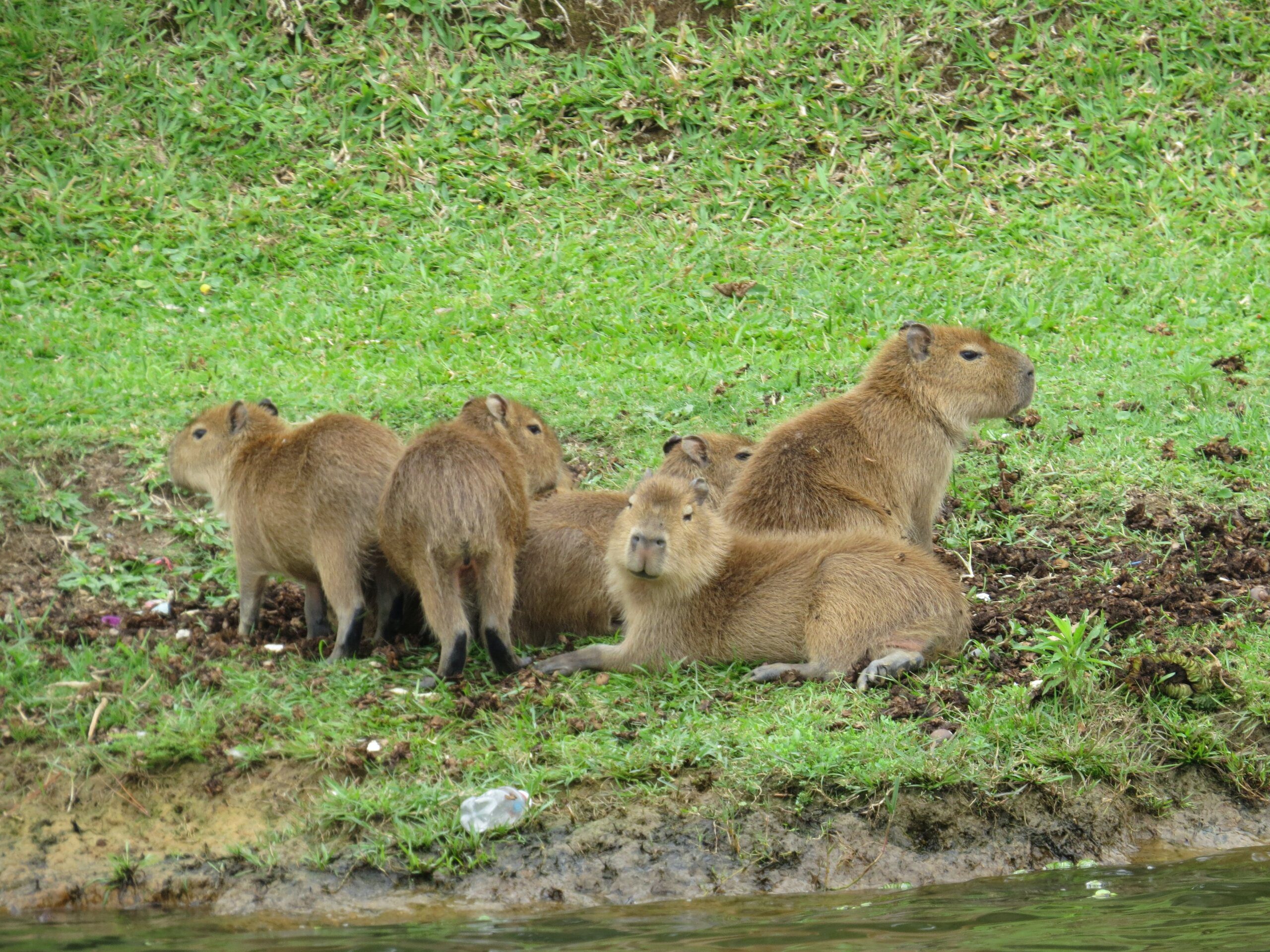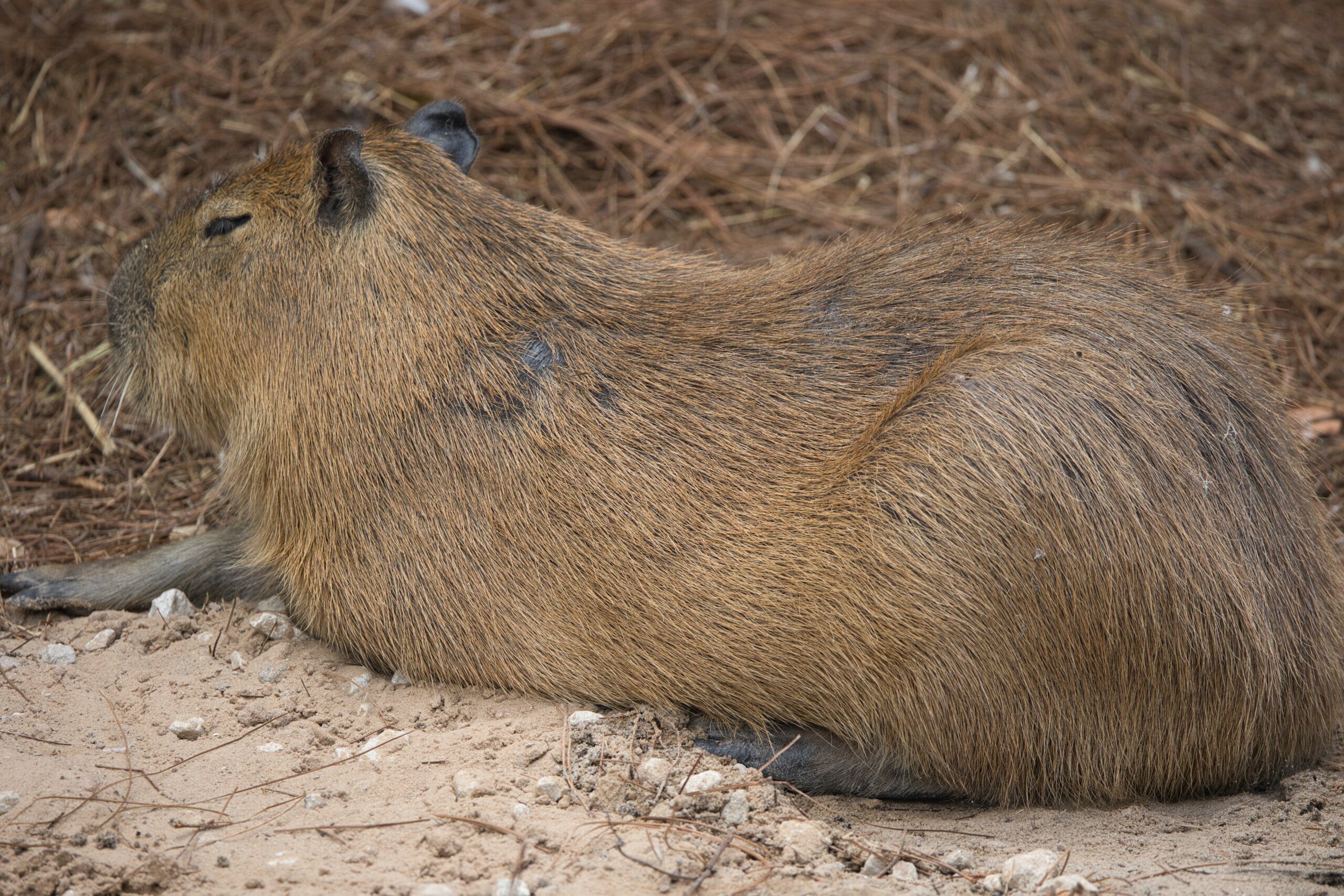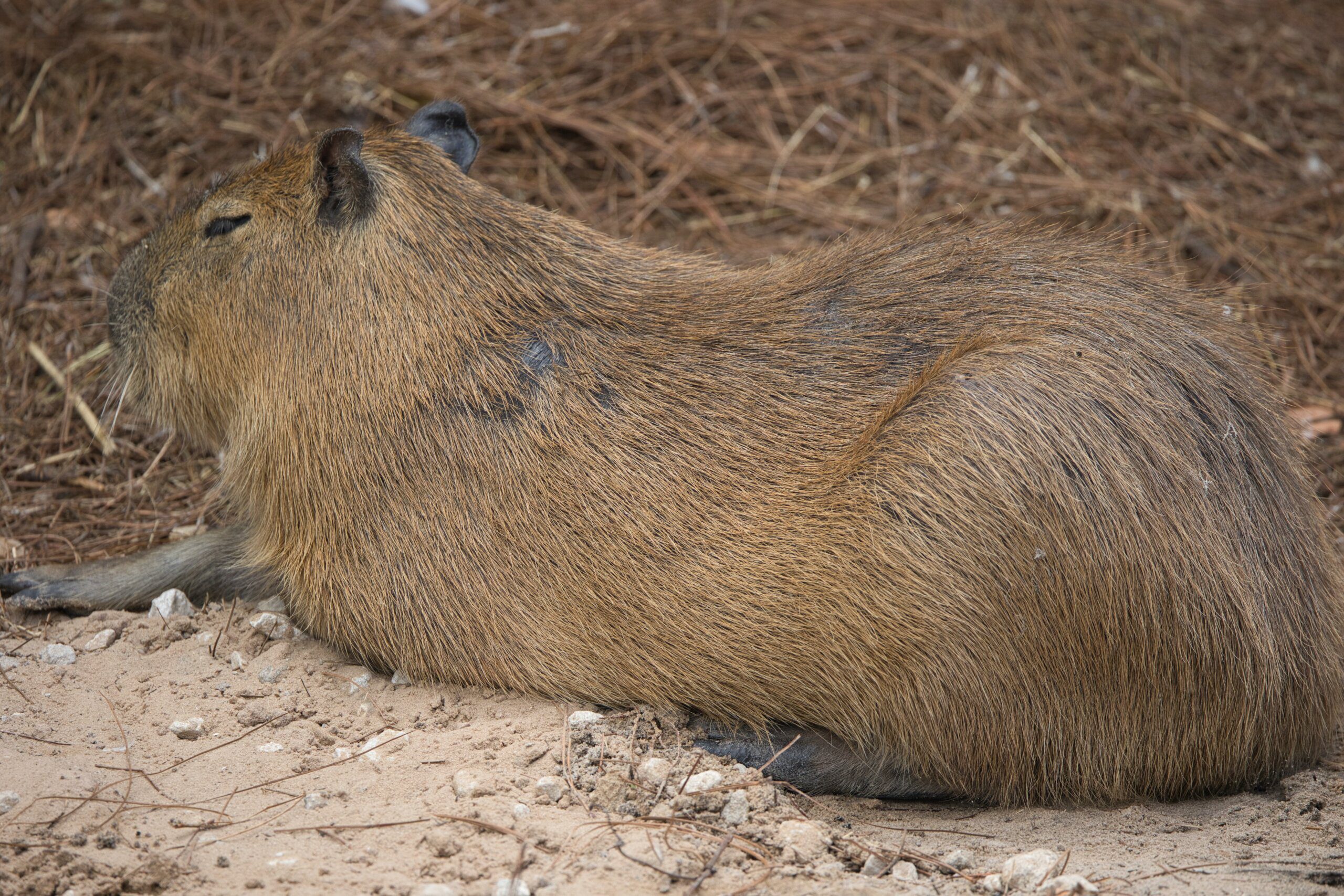Picture yourself in a serene oasis, surrounded by nature’s beauty, and in the company of the most laid-back and affable creatures on the planet. Enter the captivating world of the capybara, where their chill vibes are contagious and a warm, inviting presence beckons everyone to join in their exclusive hangout sessions. These fascinating beings, known for their social nature and gentle demeanor, have mastered the art of relaxation and harmonious coexistence. Whether it’s basking under the sun, cooling off in the water, or simply enjoying the company of their diverse pals, capybaras have made it their mission to spread their calm and welcoming aura to all that cross their path.
1. Capybara’s Social Nature
1.1 Highly Social Animals
Capybaras are known for their highly social nature. They are extremely friendly and sociable creatures, which makes them a delight to be around. In the wild, they live in large groups, known as herds, that can consist of anywhere from 10 to 100 individuals. These herds provide a sense of security and camaraderie for capybaras, and they rely on each other for social interaction and protection.
1.2 Living in Groups
Living in groups is an essential part of a capybara’s life. They create strong bonds within their herds, forming complex social structures. Within these herds, there is often a dominant male and female, who are responsible for leading and protecting the group. Capybaras demonstrate a remarkable level of cooperation and communication within their herds, ensuring the well-being and safety of each member.
1.3 Communication Techniques
Capybaras have a diverse range of communication techniques that they use to interact with each other. They communicate through a combination of vocalizations, body language, and scent marking. Vocalizations can include a variety of sounds, such as purring, whistling, and barking. Body language, such as grooming, nuzzling, and play behavior, is used to convey social bonds and establish hierarchy. Scent marking is another significant form of communication, where capybaras use scent glands to mark their territory and communicate information to other members of their group.
2. Diversity of Capybara Companions
2.1 Capybaras and Humans
Capybaras have a unique ability to form connections with humans. Their friendly and gentle nature makes them suitable companions for people. Some individuals even keep capybaras as pets, forming strong bonds and enjoying their company. Capybaras are also comfortable in human environments, and their adaptability allows them to thrive in both rural and urban settings. They can be found in various parts of the world, including zoos, parks, and even private residences.
2.2 Capybaras and Other Animals
Capybaras are well-known for their ability to get along with a wide range of animals. They have been observed peacefully coexisting with different species, including ducks, birds, and even dogs. Capybaras have a calm and non-threatening demeanor, which often helps them establish harmonious relationships with other animals. This unique trait sets them apart and contributes to their popularity among animal enthusiasts.
2.3 Capybaras and Other Capybaras
Capybaras have a strong affinity for their own kind and form close bonds with other capybaras. They engage in mutual grooming, a behavior where they clean each other’s fur, strengthening their social bonds. They also enjoy playful interactions and often engage in social play, which helps build trust and strengthen their relationships. Being highly social animals, capybaras thrive in the company of their own kind and benefit from the emotional support and companionship they provide.

3. Unique Capybara Traits
3.1 Semi-Aquatic Lifestyle
Capybaras are well-known for their semi-aquatic lifestyle. They are excellent swimmers and are perfectly suited to their watery habitats. With their webbed feet and streamlined bodies, capybaras can navigate through both still and flowing water with ease. They spend a significant amount of time in water, using it not only for swimming but also for maintaining their body temperature and finding food.
3.2 Herbivorous Diet
Capybaras have a herbivorous diet, which means they mainly consume plant material. Their diet consists of grasses, aquatic plants, and fruits. This unique dietary preference has shaped their physical characteristics, such as their continuously growing incisors, which help them efficiently graze on vegetation. Capybaras play a crucial role in maintaining the ecological balance of their habitats by controlling the growth of vegetation.
3.3 Vocalization and Sounds
Capybaras have a rich repertoire of vocalizations and sounds that they use for communication. They can produce a variety of sounds, including purring, whistle-like vocalizations, and barks. These vocalizations serve different purposes, such as expressing emotions, warning others of potential dangers, and establishing dominance within their social groups. Capybaras also produce distinctive sounds to communicate with their young or potential mates, enhancing their social interactions.
4. Capybara’s Interaction with Humans
4.1 Capybaras as Pets
Capybaras have gained popularity as unique and charming pets. Their friendly and social nature makes them suitable companions for individuals looking for an unconventional pet. However, owning a capybara requires careful consideration and preparation. They have specific care needs, including a suitable enclosure, a balanced diet, and plenty of social interaction. It is essential to provide them with ample space to roam and access to water as they are semi-aquatic animals. Additionally, maintaining their hygiene, regular veterinary care, and adhering to legal regulations are crucial aspects of responsible capybara ownership.
4.2 Capybaras in Therapy
Capybaras have also found a role as therapy animals. Their calming presence and friendly demeanor make them ideal candidates for animal-assisted therapy programs. Capybaras can provide emotional support and comfort to individuals experiencing physical or mental health challenges. Whether it’s through gentle physical touch or simply being in the presence of these gentle creatures, capybaras can help reduce stress, anxiety, and promote a sense of well-being.
4.3 Eco-Tourism and Capybara Spotting
Capybaras are a popular attraction for eco-tourism enthusiasts and nature lovers. Their presence in natural habitats, such as wetlands and grasslands, draws people from around the world. Spotting these charismatic creatures in their natural environment is a unique and unforgettable experience. Responsible eco-tourism practices ensure that capybara habitats are preserved and protected, allowing both visitors and capybaras to coexist in harmony.

5. Capybaras and Other Animals
5.1 Capybaras and Dogs
Capybaras have an incredible ability to interact peacefully with dogs, which is often surprising to many. Their calm and non-threatening nature, combined with dogs’ sociable instincts, can lead to harmonious relationships. Capybaras have been observed sharing their spaces with dogs, engaging in friendly play sessions, and even grooming each other. However, it is essential to closely monitor these interactions to ensure the safety and well-being of both animals.
5.2 Capybaras and Birds
Capybaras share their habitats with a variety of bird species, and their interactions are often fascinating to observe. Capybaras and birds can coexist peacefully, often forming mutually beneficial relationships. Birds can find safety and protection in the presence of capybaras, while capybaras benefit from the scavenging activities of birds, which help keep their surroundings clean of insects and parasites. These mutually beneficial interactions highlight the coexistence and adaptability of capybaras in diverse ecosystems.
5.3 Capybaras and Other Herbivores
Capybaras, as herbivores, often interact positively with other herbivorous animals sharing their habitats. These interactions are characterized by peaceful coexistence and the sharing of resources, such as grazing areas and water sources. Capybaras have been observed grazing together with species like deer and guanacos, displaying a remarkable ability to peacefully navigate shared territories and find harmony in their relationships.
6. Capybara’s Relationship with Water
6.1 Aquatic Abilities
Capybaras’ close association with water is a defining characteristic of their behavior and lifestyle. They possess remarkable aquatic abilities, enabling them to thrive in wetland habitats. Capybaras have partially webbed feet, which aid in swimming, and their dense fur provides insulation and buoyancy. These adaptations allow capybaras to move effortlessly through water, whether it be rivers, marshes, or lakes.
6.2 Swimming and Diving
Capybaras are excellent swimmers and can navigate through water with great agility. They use their powerful hind legs and rhythmic movements to propel themselves forward, demonstrating grace and efficiency in the water. Capybaras are also capable of diving, using their webbed feet to navigate underwater in search of food or to escape from predators. Swimming and diving are integral to their semi-aquatic lifestyle and play a crucial role in their survival.
6.3 Utilizing Water for Cooling Down
Water plays a vital role in regulating a capybara’s body temperature. Capybaras have a high tolerance for heat and use water as a means of staying cool. They often soak themselves in water, allowing it to penetrate their dense fur. The evaporative cooling effect helps dissipate excess heat from their bodies, keeping them comfortable even in hot climates. Water serves as both a recreational and practical resource for capybaras, contributing to their overall well-being.

7. Capybaras in the Wild
7.1 Environmental Adaptation
Capybaras are highly adaptable animals, capable of thriving in a range of environments. They can be found in various habitats, including rainforests, swamps, savannas, and grasslands. Their adaptability is attributed to their semi-aquatic nature, which allows them to inhabit areas near water sources. Capybaras are also well-suited to both tropical and temperate climates, showcasing their ability to cope with diverse environmental conditions.
7.2 Foraging Habits
Capybaras have specific foraging habits that are essential for their survival. They are herbivorous animals and spend a significant portion of their time grazing on grasses, aquatic plants, and fruits. Capybaras have a unique digestive system that allows them to efficiently extract nutrients from plant material. Their foraging habits contribute to the ecological balance of their habitats, preventing excessive vegetation growth and promoting biodiversity.
7.3 Predators and Defensive Strategies
Despite their friendly and laid-back nature, capybaras face potential threats from predators. Jaguars, caimans, anacondas, and large birds of prey are among the top predators that pose a risk to capybaras. To defend themselves, capybaras rely on their acute sense of hearing, agility, and the strength of their herds. They employ a strategy of strength in numbers, where the group acts as a formidable defense against predators, increasing their chances of survival.
8. Capybaras in Captivity
8.1 Management and Care
Capybaras in captivity require proper management and care to ensure their well-being. This includes providing them with suitable enclosures that mimic their natural habitat, ensuring they have ample space, water sources, and enrichment activities. Capybaras also have specific dietary requirements, requiring a balanced herbivorous diet. Regular veterinary care, including vaccinations, parasite prevention, and regular health check-ups, is essential to maintain their health in captivity.
8.2 Enclosures and Enrichment
Capybaras thrive in environments that simulate their natural habitats. Enclosures should be large enough to accommodate the capybaras’ need for space to roam and access to water. Water features, such as pools or ponds, should be provided to allow capybaras to engage in their semi-aquatic behaviors. Enrichment activities, such as hiding food, toys, and novel objects, can keep capybaras mentally stimulated and prevent boredom in captivity.
8.3 Breeding Programs and Conservation
Capybaras play an important role in conservation efforts, especially through breeding programs in captivity. These programs contribute to the conservation and preservation of capybara populations, ensuring their long-term survival. By maintaining genetic diversity and promoting responsible breeding practices, these programs help prevent the decline of capybaras in the wild. The involvement of zoos, conservation organizations, and research institutes is critical in these efforts to safeguard the future of capybaras.
9. Capybara’s Playful Behavior
9.1 Social Play
Capybaras exhibit playful behavior as a means of social bonding and communication. Play can be observed among both juvenile and adult capybaras. They engage in activities such as chasing, wrestling, and rolling around, expressing their joy and establishing social hierarchies within their groups. Play behavior strengthens their social bonds, improves coordination, and helps them develop important skills for survival and social interactions.
9.2 Playful Interactions with Humans
Capybaras’ playful nature extends to their interactions with humans. They are often described as curious and friendly animals, which can lead to engaging and entertaining encounters. Capybaras may approach humans with a sense of playfulness, seeking interaction and affection. These interactions can create unique opportunities for bonding and mutual enjoyment between capybaras and humans.
9.3 Play and Bonding among Capybaras
Play behavior plays a crucial role in bonding among capybaras, strengthening their social connections. Through play, capybaras learn valuable social skills, develop trust, and establish their place within their social groups. Mutual grooming, engaging in social play, and play-fighting are all part of the playful repertoire of capybaras and contribute to maintaining the harmony and cohesion of their herds.
10. Capybara Rural Legends and Cultural Impact
10.1 Mythological and Folklore References
Capybaras have found their place in mythological and folklore traditions across different cultures. In some South American communities, capybaras are considered sacred animals and are associated with various deities and spiritual beliefs. They are often portrayed as symbols of abundance, harmony, and protection. Capybaras’ fascinating presence in folklore adds to their cultural significance and deepens our understanding of their impact on human societies.
10.2 Capybara in Arts and Media
Capybaras have also made their mark in the world of arts and media. They have been featured in literature, paintings, and sculptures, capturing the imagination of artists and audiences alike. Their gentle and amiable nature is often depicted in artworks, portraying them as affable and lovable creatures. In popular media, capybaras have become internet sensations, with videos and images of their adorable antics gaining widespread attention and admiration.
10.3 Symbolism and Perception across Different Cultures
Capybaras hold varying symbolic meanings and cultural perceptions across different cultures. In some countries, they are associated with social harmony and communal living, representing the values of cooperation and togetherness. In others, they are revered for their adaptability and resilience, serving as symbols of survival and tenacity. The cultural significance of capybaras helps foster a deeper appreciation for these unique creatures and the role they play in our shared history and collective consciousness.
In conclusion, capybaras are highly social animals that thrive in group settings. Their friendly demeanor and ability to socialize with various species, including humans, allow for unique connections and interactions. Capybaras have a wide range of traits, including their semi-aquatic lifestyle, herbivorous diet, and diverse vocalizations. Their relationships with humans, other animals, and water further highlight their adaptability and charm. Whether in the wild or in captivity, capybaras continue to captivate and bring joy to those who encounter them. Their playful behavior, cultural significance, and ecological impact make them an integral part of our natural world.



